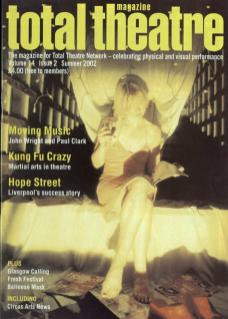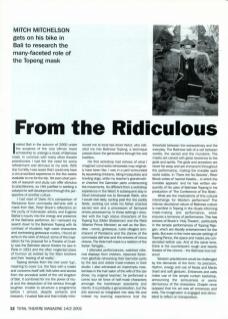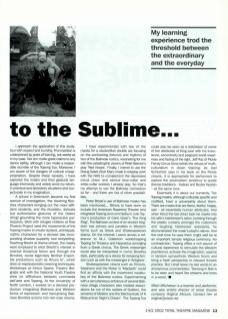I visited Bali in the autumn of 2000 under the auspices of the Lisa Ullman travel scholarship to undergo a study of Balinese mask. In common with many other theatre practitioners I had felt the need for some refreshment and stimulus to my work. With due humility I was aware that I could only have a circumscribed experience in the five weeks available to me for the trip. Yet even short periods of research and study can offer stimulus to practitioners, so I felt justified in seeking a catalyst for self-development through the perspective of another culture.
I had read of Dario Fo's comparison of Pantalone from commedia dell'arte with a mask from Bali, Peter Brook's reflections on the purity of Indonesian artistry, and Eugenio Barba's inquiry into the energy and presence of the Balinese performer. As I narrowed my search down to the Balinese Topeng with its contrast of ritualistic high caste characters and contrasting grotesque rustics, I found an echo in the work of Artaud: some of the inspiration for his proposal for a Theatre of Cruelty was the Balinese dance theatre he saw in Paris in 1931 and the often neglected place of humour as evoked by the Marx brothers and their tearing of all reality.
Topeng derives from the root word 'tup', meaning to cover (i.e. the face with a mask) and concerns itself with folk tales and stories from the ancestral world of the old kingdom of Bali. It combined for me the power of ritual and the dissolution of the serious through laughter. Unable to structure a programme before I arrived, despite contacts and research, I trusted fate and that initially introduced me to local taxi driver Ketut, who initiated me into Balinese Topeng, a technique passed down the generations through the oral tradition.
His first workshop had echoes of what I imagined commedia rehearsals may originally have been like. I was in a yard surrounded by squawking chickens, biting mosquitoes and howling dogs, while my teacher's grandmother chanted the Gamelan parts underscoring the movements. So different from a workshop experience in the West! A subsequent stay in Ubud introduced me to Semarah Ratih, who I would visit daily, cycling past the rice paddy fields, working out while his father chanted sacred text and a procession of farmyard chicks processed by. In these settings I wrestled with the high status characters of the Topeng Tua (Older Statesman) and the Patih (Warrior Prime Minister) as well as the Bondres – comic, grotesque, rustic villagers reminiscent of Pantalone and the Zannis of the commedia dell'arte and the entrées of circus clowns. The kete half-mask is a relation of the Italian Tartaglia...
I attended performances, watched informal displays from children, observed fishermen gleefully rehearsing their Gamelan parts by the sea, and visited mask-makers in their studio. I also witnessed an impromptu masterclass in the hair salon of the wife of the taxi driver, my original teacher, he performed a comic tour de force of half-mask characters amongst the hairdresser assistants and clients. It is probably a generalisation, but the arts seemed so integrated into daily life and indeed my learning experience trod the threshold between the extraordinary and the everyday. The Balinese talk of a veil between worlds, the sacred and the mundane. The masks are carved with great reverence to the gods and spirits. The gods and ancestors are never far away and are immanent throughout the performance, making the invisible spirit world visible. In There Are No Secrets, Peter Brook writes of 'sacred theatre... in which the invisible appears' and he has written eloquently of his uses of Balinese Topeng in his production of The Conference of The Birds.
My learning experience trod the threshold between the extraordinary and the everyday.
What are the implications of this cultural interchange for Western performers? The intense devotional nature of Balinese culture is manifest in Topeng in the rituals informing mask-making and performance, which ensures a temenos of performance. This has echoes of Brook's 'Holy Theatre’, particularly in the temple performances of Topeng Pajegan, which are literally entertainment for the gods. But even in the more secular settings of Topeng Panca, the space and masks are consecrated before use. And at the same time, there is the counterpoint rough and bawdy theatre of the clowns – the Balinese love balance!
Western practitioners would be challenged by the demands of the form: its precision, rhythm, energy and use of Keras and Manis (hard and soft gesture). Entrances and exits make use of the simple curtain backdrop, announcing the seriousness or comic demeanour of the characters. Chaplin once quipped that his art was all entrances and exits. The imagination is engaged and stimulated to reflect on transposition.
I approach the application of this study tour with respect and humility. This tradition is underpinned by years of training, not weeks as in my case. Nor do I make great claims to any dance ability, although I can make a reasonable stumble of the Topeng Tua. Moreover, I am aware of the dangers of cultural misappropriation. Despite these caveats, I have explored the masks and their gestural language intensively and widely since my return, in practical and laboratory situations and conjecturally in my imagination.
A school in Greenwich became my first avenue of investigation, the clowning Bondres characters bringing out the more diffident students, and the ritualistic, delicate but authoritative gestures of the Dalem (King) grounding the more hyperactive participants. Work with refugee children at Rise Phoenix Project used the movements of the Topeng masks to create stylised, archetypal, mythic characters for a devised tale incorporating shadow puppetry and storytelling. Teaching Brecht at drama school, the masks were employed to elicit Brecht's interest in oriental theatrical forms and through the Bondres, evoke legendary Berliner Ensemble productions such as Arturo Ui, which drew on expressionistic clowning techniques. Workshops at Circus Space, Theatre Belgrade and with the National Youth Theatre drew on affiliations between commedia dell'arte and Topeng. At the University of North London, I worked on a devised production integrating Balinese and Western forms of expression and transposing Balinese Bondres actions into red-nose clowns.
I have experimented with two of the masks for a vaudevillian double act focusing on the contrasting fortunes and rhythms of two of the Balinese rustics, resonating for me with the catastrophic clowns of Peter Barnes' play Red Noses. Finally, I intend to use the Orang Seket (Sick Man) mask in roleplay work with the NHS to complement the depressed circus clown and various blue-collar and white-collar workers I already play. So that's my attempt to use the Balinese connection so far – and there are lots of other possibilities.
Peter Brook's use of Balinese masks has been mentioned... Others to have done so include the American Repertory Theatre who integrated Topeng and commedia in Julie Taymor's production of Carlo Gozzi's The King Stag. The Balinese context of an ancient kingdom has echoes and parallels in Western forms such as Greek and Shakespearean drama. On the internet I came across a reference to MJ Colderion workshopping Topeng for Theseus and Hippolytus emerging from a Greek chorus. The Greek messenger could also be interpreted in comic Bondres style, particularly as a device for releasing tension such as with the messenger in Antigone.
Shakespearean clowns such as Trinculo, Stephano and the Porter in Macbeth could find an affinity with the movement vocabulary of the Balinese rustics. Experimenting with a simultaneous entrance of several Balinese village characters also created associations for me of the waiters of Goldoni, the servants of Molière and the Mechanicals of A Midsummer Night's Dream. The Topeng Tua could also be seen as a distillation of some of the attributes of King Lear with his truculence, eccentricity and poignant world-weariness and fading of the light. Jeff Raz of Pickle Family Circus fame extols the virtues of multiculturalism in clown training. As Joel Schechter says in his book on the Pickle clowns, it is appropriate for performers to explore the postmodern tendency to quote diverse traditions – Kabuki and Buster Keaton – at the same time.
Essentially it is about our humanity. The Topeng masks, although culturally specific and codified, have a universality about them. There are masks that are fierce, fearful, happy, sad – all essentially human attributes. And when Ketut the taxi driver took his masks into his wife's hairdresser's salon, bursting through the plastic curtains amongst the customers and laughing hairdresser assistants, he demonstrated the mask's playful nature. And the next time he uses them might well be at an important temple religious ceremony. No contradiction. Topeng offers a rich source of cultural experience to stimulate the Western practitioner, activate the imagination, explore in tandem sympathetic Western forms and bring a fresh perspective to relevant theatre practice. But I shall leave my last words to an anonymous commentator: 'Dancing in Bali is to be seen and heard like streams and trees in a wood.’
Mitch Mitchelson is a teacher and performer, and also artistic director of street theatre company Original Mixture. Contact him at original@clara.net


